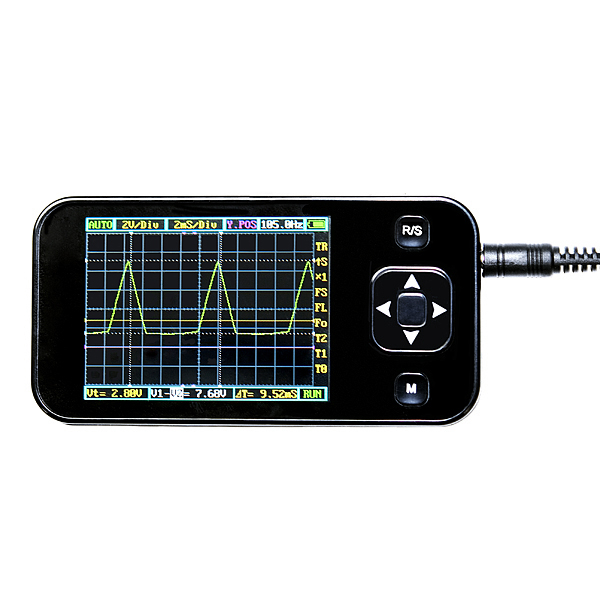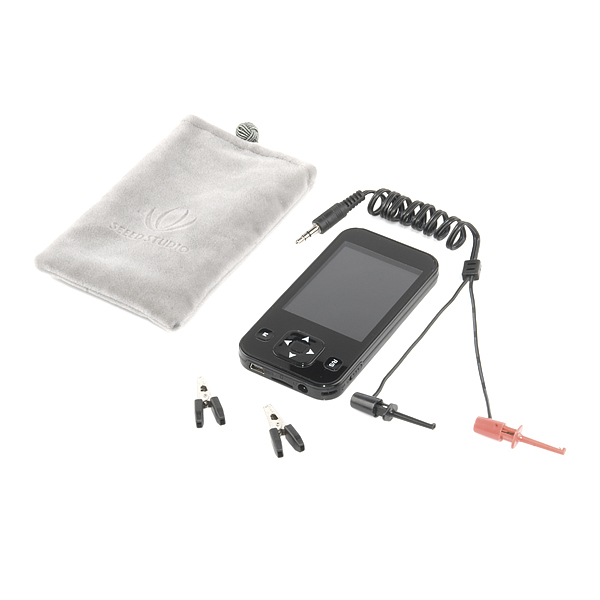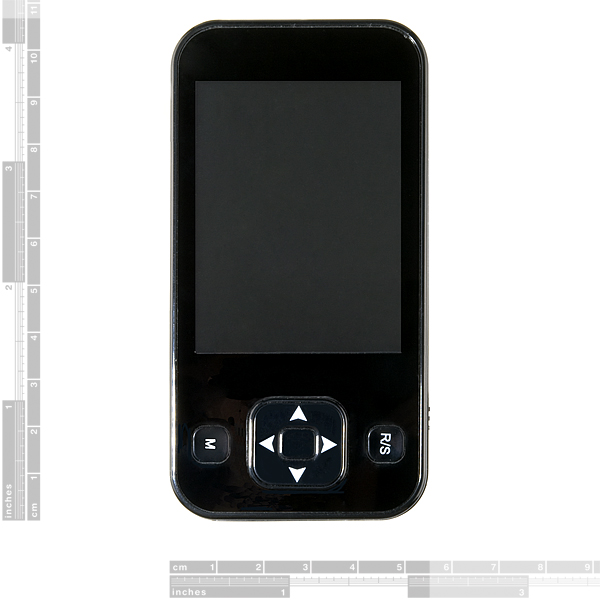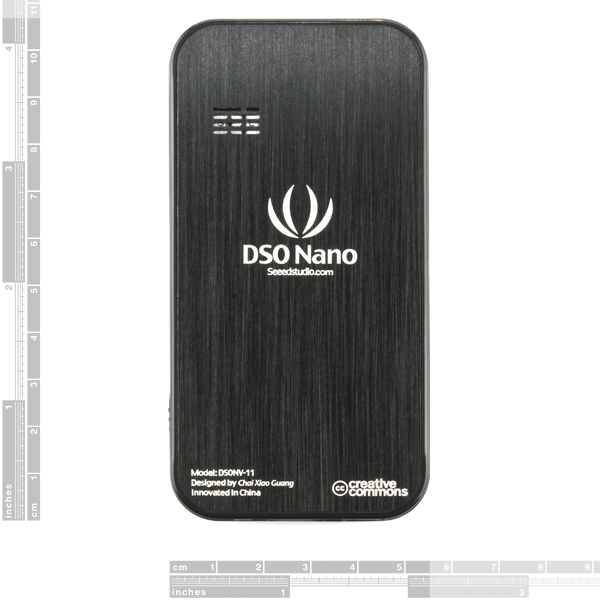DSO Nano - Pocket-Sized Digital Oscilloscope
Replacement:TOL-10244. There is a new version out. This page is for reference only.
The DSO Nano is a compact digital oscilloscope based on an ARM Cortex™-M3 compatible 32 bit platform. The DSO is equipped with a 320x240 color display, microSD card capability, USB connection, and rechargeable LiPo battery.
The DSO is easy-to-use and has a number of useful functions. It has a 1MHz sample rate, which isn't huge, but should do the job for most hobbyist use. The measurements are displayed on a 65,000 color, 2.8", 320x240 TFT color LCD. Other specifications include up to 10mV/Div and 1us/Div sensitivity, 80Vpp max input voltage, and a 1Msps 12Bits max sample rate. Waveforms can also be saved to a FAT16 formatted microSD card.
This package includes the DSO Nano, a Lithium battery, a back plate to keep the battery inside, a sleeve to protect the DSO, as well as a mini-probe and alligator clips. The battery can be recharged via USB.
- Super portable and lightweight
- 2.8” color 320*240 display
- Micro SD card Waveform Storage
- Basic 1Msps sample rate with 12bit resolution
- Functionalities include:
- Automatic measurement: frequency, cycle, duty, Vpp, Vram, Vavg and DC voltage
- Precise vertical measurement with markers
- Precise horizontal measurement with markers
- Rising/falling edge trigger
- Trig level adjustable with indicator
- Trig sensitivity adjustable with indicator
- Hold/run feature
- Various trigger mode
- Build-in test signal
- USB chargeable battery
- Open source
- 105 x 53 x 8mm
Comments
Looking for answers to technical questions?
We welcome your comments and suggestions below. However, if you are looking for solutions to technical questions please see our Technical Assistance page.
Customer Reviews
No reviews yet.





I picked one of these up from seeedstudio and let me just say its wicked!
For a hobbyist it does everything I could want.
Its compact, light, and works quite well (using it to test pwm outputs for my AeroQuad work).
I did grab a 3rd party firmware that I found through the seeedstudio forums that makes the UI a bit nicer to use (the stock firmware is a little dicey navigation wise).
All in all I like it VERY much.
chris.
Is anyone else's mouth watering? That is one of the sexiest devices I've seen a quite a while.
You better believe it...In fact...Well, I just won't talk about that. It's not decent. MUST HAS!
Open source eh? Someone should make this an android app. If this is like those "sound card" oscilloscopes I've seen, they're just using the headphone jack to take in the signal. That means they could make an android app for it.
I've seen some oscilloscope programs for android, but this seems to be more fully-functional.
Then sparkfun should sell headphone-jack oscilloscope cables!
This is a great idea, the only problem might be with the max voltage inputs. You might not want to put more than 2-5 volts into the headphone jack.
Make me a liar:D
Noooo.
Sound card inputs are not DC-coupled, do not have switchable gain, and definitely do not have an analog bandwidth of 1 MHz.
schematic image
schematic download
Besides, oscilloscope apps for Android already exist, and you can buy an ExtUSB adapter for a direct connection from Sparkfun.
Well you could try this http://letsmakerobots.com/node/5916. Not exactly the best but... sorry, OT comment.
Mine came today. Wow, what a neat little device! The packaging was quite thoughtful, as i felt like i was unboxing an iPhone. I never thought an o-scope could have so much sex appeal.
The battery has a connector, so no soldering involved. However, assembly directions are very minimal. I still for the life of me can't figure out how to get the snazzy metal back to stay on, and it took me a few minutes to determine that some random 3M sticker thrown in the box is actually a screen protector (!).
It was simple to turn on, load some Arduino PWM software, and watch it go. The buttons are not exactly the solidest in the world, but once you get used to how they work, you can easily control the highlight around the screen to adjust various settings. The frequency readout was quite nice and accurate. The screen is bright and readable, no real complaints on that front.
here's a little demo and unboxing video: http://www.youtube.com/watch?v=oZI5r_wfldo
I think this is a must have for any geek, budding uC developer as you can flip it on and get instant results why things are broken.
Actually the "random 3M sticker thrown in the box" is double sided adhesive used to mount the "snazzy metal back".
Hope this helps.
I just got mine and this is a pice of spark. The triggers don't work so forget everything witch require that (all digital signals). It says that it has the modes and the modes is in the device they just, dont work.
The manual is weary short and it takes a loot of time to understand what they mean, the UI is terrible and there are tons of bugs in the software.
The weird thing is that they release software updates all the time but they don't fix any of the problems.
Mine came in yesterday (2/16/10). After a few hours of playing with it, I have decided the software is a bit alpha. So if something doesn't work as expected, just try hitting the run/stop a few times. I can confuse it and it will leave pixels turned on that the software lost track of. My 512Meg micro SD card formatted to fat16 with the downloaded files still fails so I can't save traces.
Don't get me wrong, this thing is fun and I am glad I got it.
Source code is available and there is a software update that may fix many of my problems. Except that it runs under windows and I run Linux and Macs. Parallels doesn't work for programming it. They didn't use gcc for code development, but maybe someone with a bit more time will get that started.
It may have its limitations, but bang for buck is good.
Mark
I bought one of these direct from Seeedstudio and it is a really cool bit of kit. However, the only trigger mode that works properly is AUTO. The first time I used it in anger I wanted SINGLE mode - when the run button is pressed it should wait for a trigger, aquire a screenful and then stop. What it actually does is start the aquisition immediately and then stop, exactly what it would do if in AUTO mode and the halt button is pressed.
As has already been mentioned, only an early version of the sourcecode is openly available so it isn't practical to dive in and fix this serious bug.
If you normally use an analog scope (or no scope at all!) then you won't have a problem as you haven't come to rely on storage related features like this. Even if I knew about this problem I would still have bought it as it as it is still a very good product for the price, but with a bit more effort from the programmer it could be awesome. Is FFT analysis too much to wish for :-)
Time to carry V2! It's way better :P
the one think i would like to know about this device is can it do some of the simpler things that my multi meter can do like continuity testing, i know it cant to high voltage stuff, i would love to know if it can just give me some basic information like DC voltage i know it cant go very high on the voltage, but for what i do it would be great if i didn't have to go for my multimeter all the time if i have it on my table already.
if they could build into this guy some of the features of most miltimeters i think that would be great even it it has to have another set of inputs that would be great.
i just have this little guy now, it works great but its far from its bigger brothers,href="http://www.mygreenlee.com/GreenleeDotCom/Products/main.shtml?greenlee_category_id=6&product_category=157&adodb_next_page=1&adodb_next_page=4&adodb_next_page=3&portalProcess_2=showGreenleeProductTemplate&upc_number=11689">http://www.mygreenlee.com/GreenleeDotCom/Products/main.shtml?greenlee_category_id=6&product_category=157&adodb_next_page=1&adodb_next_page=4&adodb_next_page=3&portalProcess_2=showGreenleeProductTemplate&upc_number=11689
It doesn't check continuity or measure capacitance. It's a standard oscilloscope that plots voltages generated by the probed circuit. To check continuity the device would have to supply its own voltage to the circuit and this one doesn't (as far as I know, no oscilloscope does). It's designed as an addition to a multimeter, not a replacement. It does measure DC voltage, frequency, duty cycle and so on (look though the manual for the list of features).
This does have a waveform generator and output. So it could be configured to measure continuity, impedance, frequency response, distortion, etc. But I bet it doesn't.
I use DSO for field testing accelerometers, gyros, sonic and IR sensors. The device has a tolerable self noise. It's sometimes gets flaky when changing scan modes, back and forth, but overall it's well worth $100.
The closest thing to DSO I could find was made by Saelig (http://www.saelig.com/PSHA/PSHA025.htm)
DSO:
10mv-80V, 1MHz, 1 channel, $100
Saelig:
50mV-500V, 5Mhz, 2 channel, $400
If you don't plan on capturing serial data streams, or working with outlet powered electronics, then get DSO's for 1/4 price of Saelig scope. For data acquisition or household appliance testing go high end.
Cheap Junk.
Pulling the screen protector off showed two round scratches.
Then trying to actually use it - they apparently don't know the definition of AUTO and NORMAL. Nor could I get the trigger location to move.
There is this stupid purple waveform that seems to be stuck - something unknown makes it go away. It doesn't remember settings between powerups. The UI is completely bizarre, the buttons are like navigating through a maze to get to the different settings.
I couldn't even get a simple UART output to show one or two characters onscreen with the trigger at 10%. Maybe it can do it, but it isn't at all clear.
I will probably end up using it for something, but
IF YOU NEED AN ACTUAL WORKING OSCILLISCOPE DON'T WASTE YOUR MONEY ON THIS.
Yes, I read the manual. Apparently it has a junk waveform it leaves there until you change some timing or voltage parameter so you have to do that whether you want to or not to get rid of it. I did the hold RS, press M to save, but it doesn't work - it flashes like it sees the buttons, but it doesn't say anything and nothing is saved.
I was one of the luck 65 or so people to purchase this scope before Sparkfun ran out of stock and I've been using it for just about a month now. This is the first oscilloscope I've owned and I must admit that I'm very pleased with it overall.
I was a bit skeptical when I first opened the package. The scope felt cheap like a non-functioning demo model of a cell phone in the store (all the guts removed and all you're left with is a plastic shell), but after starting it up the first time, I was quite pleased with the quality of the screen and graphics. It is very responsive to user input as well as signal changes. The screen doesn't seem to lag at all.
The 4-way directional key pad leaves a bit to be desired though. If you want to press the down button you actually have to press on the bottom right corner of the directional key pad. If you don't, it's likely to read the key press as a left button key press because the actual buttons are not placed directly beneath the arrows on the key pad.
The scope includes a 1 cell lithium polymer (LiPo) battery and seems to provide good run time. I have only left mine on for about a 1/2 an hour between charges but even at that, it didn't sink the battery level below 50-60%.
When it will be available?
Both Document Links, Product Manual and Customize Your DSO's Interface have the same link.
The "Customize your DSO's Interface" link is incorrect. Real document on the manufactor's page here: http://www.seeedstudio.com/depot/micro-digital-storage-oscilloscopedso-nano-p-512.html
Also, I can't seem to find the source code. Anyone have a link?
DSO V1.1 open source code: http://www.seeedstudio.com/forum/viewtopic.php?f=12&t=510
But that's not the "current" 2.x FW. "there is some third party code included in V2.X F/W and we don't have the authorization to publish them" http://www.seeedstudio.com/forum/viewtopic.php?f=12&t=534
Does anyone know how to get the save waveform working? I just uploaded the latest version 2.5 firmware to it, but have still not yet found a version which saves the waveforms. I have a 2GB micro SD card, and have tried formatting it fat and fat32, but dso reports "File NoPlace" when trying to save a waveform. Loading any file number just loads the purple damped oscillation default waveform. After attempting to write with the scope, my mac reports the card as unreadable, which is then fixed by reformatting.
Tony
I'm on firmware 2.4 and I can save files. The DSO
panel on the right has FS mode for "file save" and FL for "file load". If the MicroSD card is not inserted or not formatted properly, then the selection highlight just skips pass those items.
I'm also using a 2Gb MicroSD, but I formatted it using FAT16. That could be the reason why it's working.
If Windows formatting doesn't produce a readable card, try Panasonic Flash utility (works with all brands): http://panasonic.jp/support/global/cs/sd/download/index.html
That waveform isn't too hard or bothersome to turn off, you just have to change your scale and it disappears. The firmware is kinda iffy right now, I recommend Pauls firmware, works a lot better.
http://code.google.com/p/dsonano/downloads/list
Vasago: _ ... then using the included double sided tape to adhere the aluminum plate to the back of the scope. ... _
Wait a second. Are you saying that the only thing holding the back of the case on is a piece of double-sided tape?
lol, yeah, that's what I'm saying. It's a large piece of double sided tape that covers the entire back cover except where the battery is located. It works just fine as long as you don't want to (easily) open the case up again.
Is there enough room on the edges to drill and tap a few holes so you can screw the back cover on?
Seems like a cheesy way to put together a really nice looking device.
I'd say if you were careful enough, you might be able to, obviously this would void the warranty, but it seems like there's enough room on the end with no buttons for a screw.
I've had mine a bit, and I do like it. It's no bench top $2k unit, but it helped me analyze and debug a project I was working on that involved R/C servo signals.
And the trigger modes are a bit wonky, I just flip through them all till something works.
It is what it is. For some it might just be perfect and for others it's going to be a paper weight. We're glad it worked out for you!
calle, sorry it didn' work out for you! :-(
Just got mine, cool little gadget. Three questions:
1) Is there a firmware update so you can capture to the SD card w/o a PC connected?
2) Does the microphone work? How do you set the DSO nano to capture off of the mic input?
3) Is there an FFT mode?
Careful with this Scope. I broke my screen after about a week with it. Good thing is Seeed Studio carries a replacement screen which is pretty easy to install. Hopefully Sparkfun will carry the screen as well.
If battery life is a concern of yours, you can always plug it into a USB port of your computer for unlimited usage.
There is a very small amount of assembly required which basically amounts to plugging in the battery, stuffing it in the back of the scope and then using the included double sided tape to adhere the aluminum plate to the back of the scope. Once you've done that, plug in the probes, power it up, and you're ready to go.
The user interface leaves a little bit to be desired but once you get used to it, it's really not that bad. As an earlier post mentioned, 3rd party software is available which tweaks the UI a bit. I haven't tried it yet but I plan on doing so in the near future.
All things considered, I am very pleased with the scope and given the choice again, for $100 I would definitely purchase it again. Now that I have it, I'm not quite sure how I managed the last 10+ years of microcontroller programming and hobby robotics without a scope!
i dont know if it is just me but they seem to have ran out of a few bigger items like this lately, i am waiting for them to get stock of there soldering iron that i want to order
Can I analyze analog and digital signals with the DSO Nano?
I see logic analyzers that only do digital and I see oscilloscopes that only mention analog and others that specifically mention both analog and digital. Looking at the pdf I would think it can analyze both, but just double checking.
Thanks.
I can't imagine that any hardware connected to the audio input/output on a phone would be able to sample above 44 KS/s either. But maybe they use a general purpose DSP for everything.
I'll wait for the 100MS/s version.